Why Should You Prioritize Fall Protection for Your Workers?
Why is it more commonplace for companies to be assessed and pay fines instead of providing fall protection for their workers at height? Instead of getting hefty fines from OSHA, companies can educate themselves on proper fall protection practices for their workers.
Recently, a Northeast Ohio contractor was fined more than $400,000 for repeated violations for failing to protect workers at height.
Unfortunately, fines like this are not an uncommon occurrence, as OSHA (the Occupational Safety and Health Administration) has ramped up enforcement of its standards. Last year, general fall protection requirements were OSHA’s top-cited violations. In fact, four of OSHA’s top 10 citations were fall protection-related to one of the following:
- Ladders
- Scaffolding
- Fall protection training
Almost all of 2022’s largest fines were penalties for failing to comply with fall protection regulations.
For this article, we reached out to Kevin Muldoon, the Product Manager of Engineered Lifeline Systems and Fall Protection from Mazzella and Dan Montchal, the Regional Sales Manager at Tractel, a company offering world-leading safety solutions for working at height. They will help answer the question of why companies need to prioritize fall protection for their workers.
Why Aren’t Companies Prioritizing Fall Protection to Their Workers?
One of the biggest factors seems to be a lack of education.
Either people just don’t know about the requirements, or they’re not up to date on new standards. Also, it could be an old mindset of “this is the way we’ve always done business” and companies / managers don’t see a reason to change it.
Oftentimes, fall protection specialists hear familiar pushback from experienced workers, including:
- We’ve never had a fall
- Nobody’s ever gotten hurt
- It slows down the work being done
Why Is Fall Protection Education and Training Necessary?
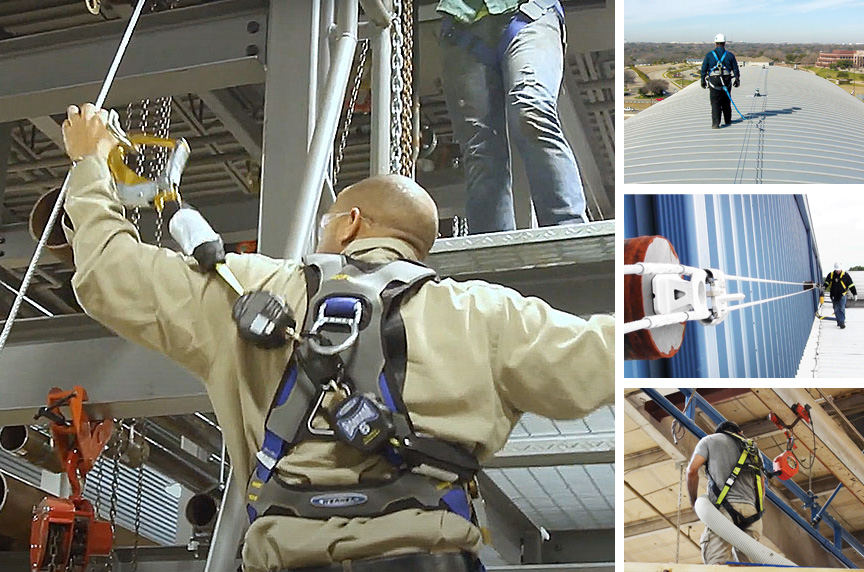
When you’re working at height, the height’s the danger. You have to ask, “What is being done to protect yourself from falling?” Well, if your company followed best practices and adhered to industry standards, you already would know that answer.
Required Training
OSHA 1910.30 states that: “The employer must train each employee in at least the following topics, including the:
- Nature of fall hazards in the work area and how to recognize them
- Procedures to be followed to minimize those hazards
- Correct procedures for:
- Installing
- Inspecting
- Operating
- Maintaining
- Disassembling
“The correct use of personal fall protection systems and equipment including, but not limited to, properly hooking up anchor points and tie-off techniques, and methods of equipment, inspection and storage as specified by the manufacturer.”
Since 2017, OSHA has been citing companies for not training their employees who work at height.
Implementing fall protection for your employees can be expensive and daunting at first. If you haven’t been proactive in developing fall protection plans, it sometimes takes something drastic (i.e. an injury or fatality) for opinions to change and companies to get in line with the standards.
Using Equipment Properly
If your company does invest in fall protection systems or equipment, it is your responsibility to understand how to use them properly. Mazzella Fall Protection Specialists have seen roofers put on harnesses and even have a lanyard connected to their side D-ring. While it looks like they’re tied off or they’re compliant, they’re really not.
From a maintenance or productivity standpoint, workers may make the excuse of, “It’s going to take me more time to do this job, so I’m not going to be tied off. I’m just going to clip it to my side D-ring, and I can move a lot faster.” In their minds, they’re like, “I’m not going to fall,” but that’s exactly when fall protection really is needed.
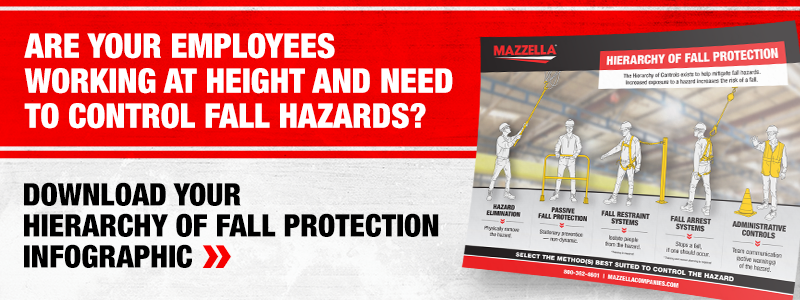
Why Does Selecting the Correct Equipment Matter?
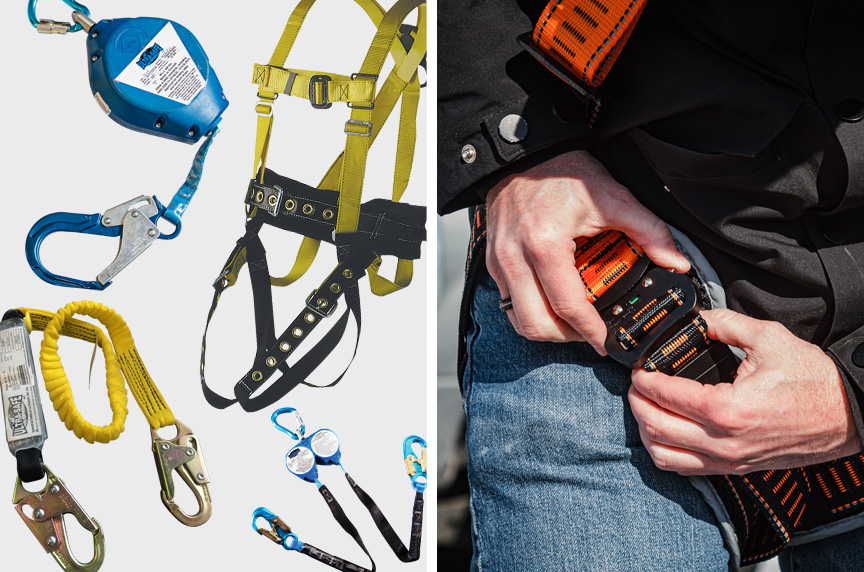
Selecting the proper equipment for the work you’ll be doing at height is another hurdle for fall protection compliance.
There are many types of harnesses, lanyards, other fall protection soft goods, and complete systems, including mobile fall protection. Deciding which equipment is the right fit for your needs can be daunting.
To make the best decision for you and your workers, you need to speak with fall protection specialists and get answers to the following questions:
- What is the work being done at height?
- How much time are you going to spend in your harness?
- Do you need a compliance harness or a more substantial harness?
Compliance harnesses are not comfortable. It’s something that you want to get out of because it’s really restricting. If you are working at a job where you’re going to be wearing a harness for several hours, it is important to pick the right gear. This will help prevent you from having issues, and also, help workers be more compliant with wearing their fall protection equipment.
Just driving to and from other jobsites, Mazzella Fall Protection Specialists have seen people, especially roofers, who have their harnesses on. They’ll be up on a roof, but they unstrap their legs, which, if a fall happens, the harness will not protect you properly and could fail.
Again, it cannot be understated how much you need to make sure you have the right equipment for your work. Also, by making sure your employees are comfortable using their fall protection equipment, they’re more likely to follow the rules, and hopefully, ensure nothing catastrophic happens.
Who Is Responsible for Worker Safety?
On the jobsite, who is responsible for worker safety?
Is the responsibility that of the workers who are just not wearing their gear properly? Does it fall onto the company itself and the culture that they have created?
Ultimately, the answer is: YOU.
However, OSHA 1926.501 states the employer has a duty to provide fall protection in the construction industry. Also, OSHA 1910.28 says that in general industry, the employer has the duty to provide fall protection equipment.
The employee knows that, “I’m responsible for my safety and the employer has a duty to provide it.”
Additionally, the employer is responsible for providing training to the employees so they know what they need to be wearing while working at height.
Why Is a Job Safety Analysis So Important?

Conducting a job safety analysis (JSA) focuses on the relationship between the worker, the task, the tools, and the work environment — and identifies hazards before they cause catastrophic injury / death. It is the most effective way to assess safety management on your jobsite or in your facility.
Hazards are the main cause of occupational health and safety problems. Identifying hazards is one of the first things you can do to help keep your jobsite safe. OSHA defines a hazard as a condition, or set of circumstances, which present a potential for harm. A hazard is often associated with a condition or activity that will cause illness (health hazard) or physical harm or injury (safety hazards).
After a hazard is identified, a determination is made on how to control or eliminate the hazard altogether. This plan needs to be communicated with all individuals involved to gain clarity on safe work. Anytime the job, task, or situation changes, the JSA plan needs to be revisited.
Taking the time to perform a job safety analysis is truly invaluable.
Also, working with a third-party company to build out a safety manual and plan would be helpful. If you have a customer that does well with its safety program, you could take information from them and adapt some of their policies to fit your needs.
Lastly, having your insurance providers conduct risk assessments on “walk-arounds” through your facility or jobsite is another way to help in the creation of your in-house safety program. They can call attention to certain risks that can help you put action into making improvements.
Are Companies and Workers Becoming More Receptive to Fall Protection?
In recent years, Mazzella has seen companies become more receptive to adding / improving their fall protection measures. In fact, during the setup for the podcast episode, our Fall Protection Specialist received three calls from companies that needed fall protection goods and / or services. That alone signals companies are really understanding they need to be compliant and protect their employees.
More companies are caring about safety and making it a priority. Although there is still a long way to go to get more companies compliant and less that are being reactionary because of an incident or OSHA fine, Fall Protection Specialists are making sure people are educated when it comes to fall protection.
OSHA is doing a good job because what it’s doing is saying, “Okay, this is a recordable incident.” If a roofing contractor has a recordable, and they’re looking for another job, and part of the criteria for getting that job is to having none or very few OSHA recordables, you hit them in their pocketbook. They’re going to understand that, “We’ve got to be safe, and we have to work safe.” Nobody wants to hire unsafe workers, and more companies are hiring safety managers to create safer working environments.
How Can You Combat the Mentality That Fall Protection Isn’t Important?
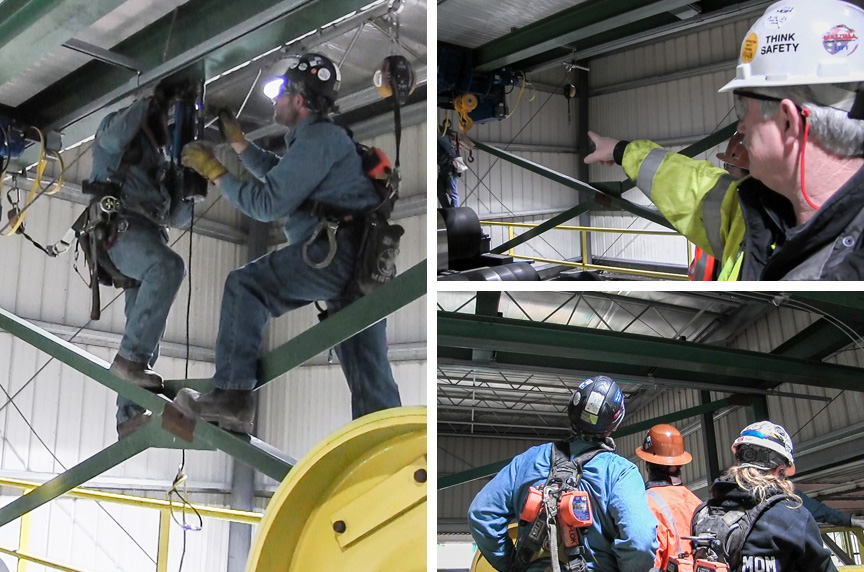
Oftentimes, Fall Protection Specialists hear that “productivity will decline because it restricts workers from doing their jobs.”
However, what is not typically considered is there are many solutions that are not restrictive to the worker. Education helps, and once they understand the benefits of fall protection, then they’ll use it. If they don’t understand it, they have a negative connotation toward it, and don’t want to do that.
There have been many technological advances in fall protection in the past decade, and it is far more than just about harnesses and lanyards. Companies like Tractel, as well as other fall protection systems manufacturers, have come up with new products. However, education still is the key.
If you have a job where you’re going to be restricted, that’s when you need to bring someone else in. Often, they’re going to have a solution that isn’t going to restrict you, and you’re going to be able to perform your job as well you did before, but also, being safe while doing it.
When educating the customer, Mazzella will share concept drawings of anchor points that were designed and built to industry specifications. Giving a visual representation of what a system could look like often clears up any confusion. It is better to invest that time and have a company say, “Oh, okay. That’s how that works,” rather than looking at the complexity of a project and having them say, “Forget this. We’ll do it without fall protection.”
What Are OSHA’s Requirements for Working at Height?
What Mazzella Fall Protection Specialists have found in recent years is when people who talk about OSHA and fall protection, they don’t understand that OSHA generally classifies fall protection into two areas:
- Construction
- General industry
Construction is governed by the OSHA 1926 standard, while the General Industry standard is OSHA 1910, and height requirements for fall protection are different. For construction, fall protection must be used when work takes place at 6’ or higher off the ground. For general industry, it’s 4’ or higher.
Fall Hazard Identification
OSHA comprehensively looks at hazard identification as a way to protect workers at height. Once a hazard is identified, the focus shifts to controlling the risk. When dealing with a height hazard, you’re talking about either eliminating or controlling it.
A lot of times, you cannot eliminate the hazard. If that is your situation, you use the hierarchy of fall protection, which is a series of controls to limit hazards that come from working at height.
There are many types of fall protection measures, including:
- Lifelines (vertical and horizontal)
- Guardrails
- Fall restraint
- Fall arrest
It is paramount that you select the best option based on your jobsite needs. OSHA inspectors may look at your situation and ask the following questions:
- What are you doing to keep your workers safe?
- Is a competent person on site?
- Do you have a qualified person?
- Was the system you’re using designed by an engineer?
What Are the Consequences for Not Providing Proper Fall Protection?
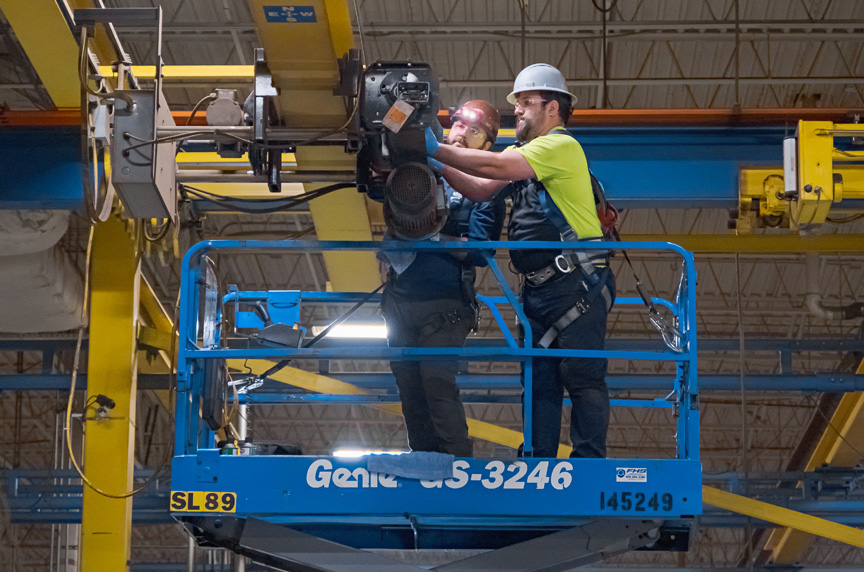
Obviously, the largest, and most devastating, consequence happens when a worker is injured or killed.
Plus, OSHA’s really cracking down, and not only are you getting fined heavily for violations, but specifically, with repeat violations, that fine increases substantially. If companies don’t start abiding by OSHA’s regulations, then it’s really going to hurt their financial bottom line.
A woeful violation is a repeat violation, and carries with it a severe fine. To that point, a company that receives a woeful violation fine is going to get a reputation of having unsafe operations. That reputation not only costs you in fines, but also, potential losses of future work.
How Can Employees Advocate for Better Fall Protection In the Workplace?
Fall Protection Specialists recommend you go to the walking-working surface at height, and see what the fall protection requirement is. Prior to either being employed or whether you’re still employed there, you can go to your safety manager and present your research.
Be sure to address that in 2017, OSHA released a final rule that workers at height need to be trained “because part of their job requirement, as you describe it, is working 4’ or higher if it’s general industry or 6’ in construction.”
Let it be known that you’d really like to be trained by asking, “Do we have a training program?” If your company doesn’t have a program in place, then reach out and get trained yourself. It’s something that you can take action on and say, “Hey, I know this is the law, and nobody wants to work for a company that doesn’t follow the law.”
An employee should always be able to reach out to a safety manager or someone in management and voice safety issues or concerns. At the end of the day, if that company isn’t willing to listen to your concerns, they’re showing a lack of care about their employees.
Also, if you see that your company isn’t implementing any training, by law you can stop working. Employees have multiple avenues, but there should be someone within your company to speak to and have advocate on your behalf.
For potential employees, ask to see JSAs. That is showing the company cares about the safety of their employees. You want to know they’re safe and practice safe principles.
How Has Fall Protection Evolved?
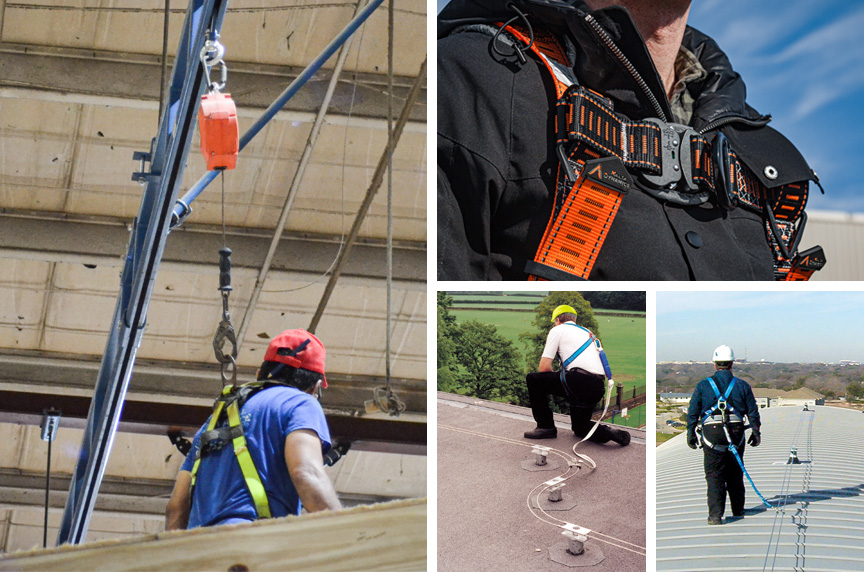
We can all think of the picture of the workers eating their lunch on the beam at the Empire State Building, or people just tying a rope around their waist. But how has fall protection improved, or evolved, over time?
Especially over the past decade, fall protection equipment has become more comfortable. This is true with harnesses that come with shock-absorbing technology. If you do experience a fall, it takes stress off of your body. It will not cause as much discomfort or damage as it used to.
Also, there are a number of different systems that instead of catching you during a fall, will restrain you and stop you from even getting to the edge. It stops the fall from even happening, so you’re not going to go anywhere.
Many new products are being manufactured for general or specific industries. During this developmental stage, companies will send prototypes to customers in the field and get real-time feedback on its effectiveness or improvements that could be made. With this level of testing, companies are looking to answer the following questions:
- Is this something that you would use?
- Will it be comfortable?
- Are there things you would like to see change?
Fall protection companies are manufacturing products for people to use. They want those end-users to feel comfortable with trusting their safety to that company and those products in use. By getting this critical feedback, they’re able to design products specifically for the people that are using them on specific jobs or in specific industries.
What Is the Inspection Process for Fall Protection Equipment?
Regular inspections are very important to maintaining the trust and safety of your workplace. Mazzella uses forms within our company that actually show the following information on your fall protection system, including the:
- Manufacturer
- Date of install
- How many people are on it
- Manufacturer model number
- All other information pertaining to that particular piece of equipment in your facility
We’re not just going to fill out the form and hand it to you along with an invoice. If you have any questions about it, we show you the form up front, and then, walk you through what we’re talking about. Before workers attach to the fall protection unit, they need to see that it was inspected, and it was inspected annually. In some cases, if it’s a manufacturer specification, it’s before each use or every six months, whatever is needed to be compliant.
This way, if you had an OSHA audit looking for the last time your system was inspected, we can produce that document for you, show you the date and when it was done. That provides you with peace of mind that the equipment is safe when your workers are doing their jobs while tied to it.
Inspecting Personal Fall Protection Equipment
Failure to inspect personal fall protection equipment is one of the top 5 reasons a business isn’t OSHA compliant.
According to ANSI / ASSE Z359.2:
Fall protection equipment shall be inspected by the authorized person at least once at the beginning of each eight-hour shift in which it is used to verify that it has not sustained any wear or damage that would require its removal from service. Fall protection and fall rescue equipment shall be inspected on a regular basis not to exceed one year (or more frequently if required by the manufacturer’s instructions) by a competent person or a competent rescuer, as appropriate, to verify that the equipment is safe for use.”
Properly inspecting your personal fall protection gear for damage or irregularities prior to each use is the best way to help keep everybody safe. Keep in mind fall protection harnesses, lanyards, and retractables are the last lines of defense to help keep your employees safe in the event of an accidental fall from height.
Industry standards also require your fall protection equipment inspected, at a minimum of once a year, by a “competent person” who has been certified for that specific task by their employer. There are many third-party companies who can train members of your team to properly size the equipment, inspect it to identify any abnormalities, and ultimately, determine if it needs to be removed from service. Best practice is to retain documented inspection records for two years.
You should familiarize yourself with the following standards relating to personal fall protection and their removal from service criteria:
- ANSI / ASSE Z359.11 – Safety Requirements for Full Body Harnesses
- ANSI / ASSE Z359.13 – Personal Energy Absorbers and Energy Absorbing Lanyards
- ANSI / ASSE Z359.14 – Safety Requirements for Self-Retracting Devices for Personal Fall Arrest and Rescue Systems
How Can Mazzella Help With Your Fall Protection Needs?
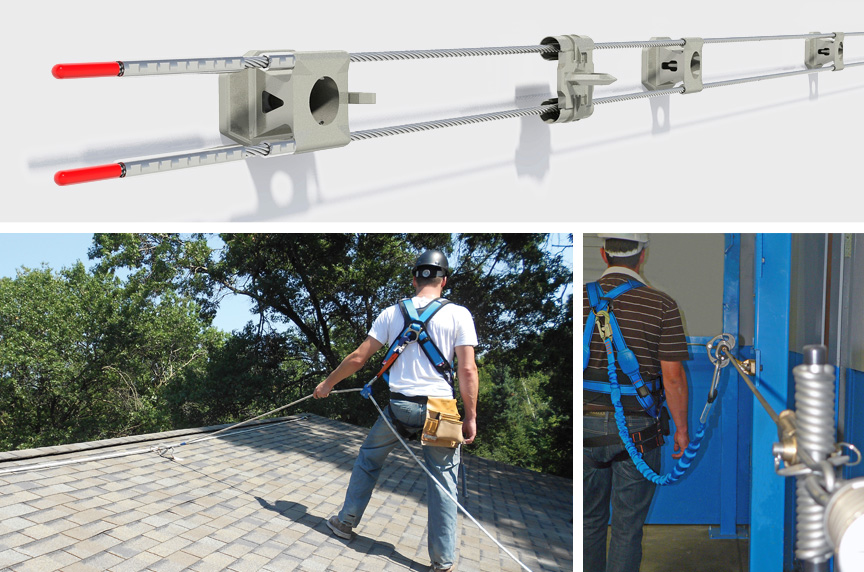
Accidents while working at height are one of the biggest causes of workplace injury and death. You need to do your work safely and correctly. We can help with your fall protection needs, plans, equipment, and training.
Mazzella has custom-configured several types of fall protection systems for businesses across the country that have diverse needs based on their working conditions. Also, we are a distributor of The XSERIES Mobile Grabber® fall protection units.
Mazzella is a leading supplier and installer of engineered fall protection systems in the U.S., as well as a distributor of soft goods, including harnesses, lanyards, self-retracting lifelines, scaffolding and netting. All of our engineered systems and products meet or exceed the federal criteria required by OSHA and ANSI and can be customized with your individual fall protection and financial needs in mind.
Mazzella specializes in jobsite analysis and evaluation, as well as employee training for equipment installed or products sold. Also, we offer:
- General training
- Systems inspections
- Documentation storage
- Procedure development (i.e. rescue plans)
Rigging inspections are what Mazzella is known for. However, personal fall protection inspections pair well with our rigging inspection division.
What our rigging inspectors have found over the years is that while looking at all of the rigging in a facility, many of the workers using this rigging also use personal fall protection. Through our personal fall protection inspection training, we are competent to conduct these inspections.
Call us at 800.362.4601, or click here if you need harnesses or other fall protection equipment!
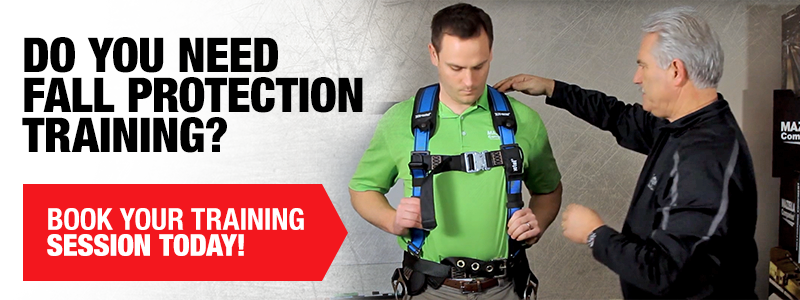

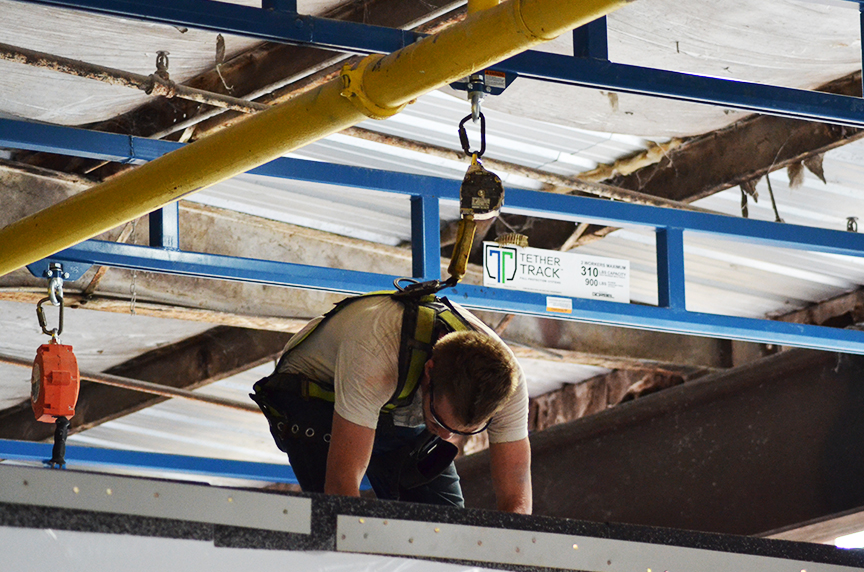
Fall Protection
Mazzella is a leading supplier and installer of engineered fall protection systems in the U.S., as well as a distributor of soft goods like harnesses, lanyards, self-retracting lifelines, scaffolding and netting.
We specialize in site analysis and evaluation, as well as employee training for equipment installed or products sold. Also, Mazzella offers general training, system inspection, documentation storage, and procedure development, like rescue plans.
Copyright 2023. Mazzella Companies.
